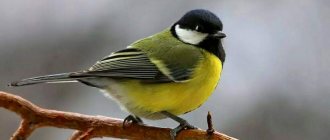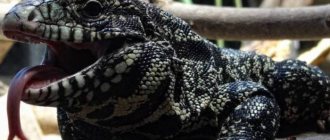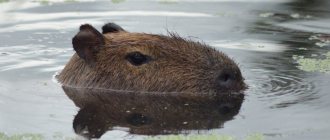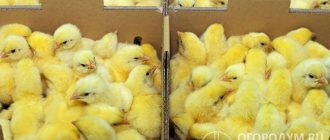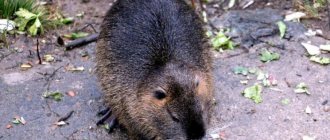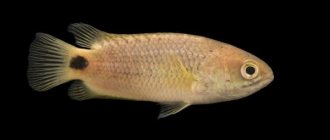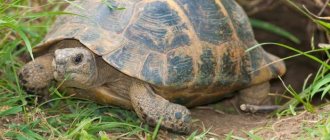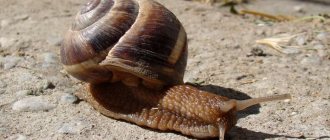A tit at home can live happily ever after. The main thing is to choose the right diet for her, which is not always easy, because she eats insects and grains. The bird adapts well to life next to humans; it is important to create suitable conditions for it. We will look at what exactly needs to be done for a bird to live in captivity in this article.
Tit
Is it possible to keep tits at home?
How to raise a tit at home and make it your pet? Before answering this question, you need to weigh the pros and cons of keeping this small bird at home.
Arguments for":
- not afraid of man;
- easily accustomed to life in captivity;
- they sing beautifully;
- simplicity of content.
Arguments against":
- difficulties in training adults;
- if you put an adult tit in a cage, it may refuse food and water, as a result of which it will die;
- most birds are infected with helminths, which are easily transmitted from bird to person
Tame tit
Before keeping a tit at home, you need to carefully consider this decision and understand the responsibility that you take on with such a bird.
Lifestyle
Great tits are not migratory birds by nature, but are forced to move to cities to survive the winter. They themselves are extremely restless and constantly move from branch to branch. Moves between trees by jumping. In late spring, tits look for food on deciduous trees, and in the fall they move to coniferous forests. The great tit's voice is remarkable, like the ringing of a bell. In total, there are up to 40 variations in the sound of the great tit. They can also combine sounds into one song by slightly changing the timbre of their voice.
Types of tits for home keeping
Do tits live at home? Most species prefer life in the wild, but some species can coexist with humans.
Great tit
An interesting individual who loves solitude; she is intolerant of other birds. This species of tit is very active and energetic. The bird weighs about twenty grams and has a body fifteen centimeters long. The tit's plumage is bright, its belly is lemon-colored, and has a longitudinal black stripe on it.
Blue tit
The blue tit is a species of tit that can be kept at home. This bird immediately catches the eye and is distinguished from other species by its bright blue plumage.
Blue tit
This individual is friendly and mischievous, can be cocky and cautious.
Moskovka
The titmouse is small in size, the smallest in this family. It has a light gray belly, bluish-gray wings and back, and a black head. Only her cheeks and neck are bright white.
The Muscovy is very mobile; if it forms a pair, it retains it for life. This individual can be tamed within a week; it is very trusting and easily gets used to people.
Swamp chickadee
This titmouse weighs no more than eleven grams. She has a black chin and throat, and the tips of her feathers are edged with white.
This bird has a sharp, shrill voice. She loves birch sap and feeds on seeds, fruits, and invertebrates.
Swamp chickadee
Nutrition
Great tits prefer to feed on caterpillars during warm periods. This is one of the rare representatives that can easily cope with the hairs of caterpillars that are saturated with a dangerous toxic substance (list of poisonous caterpillars). In order to safely feed on caterpillars, great tits pinch it with their paw and make a small side hole with their beak, and then suck out all the insides of the prey through it.
It is noteworthy that some great tits have become adept at pecking at milk bottles during periods of famine. In cities, birds do not hesitate to eat food that is placed in feeders. For example, they can easily cope with lard and frozen meat.
These representatives themselves are absolutely omnivorous. Their diet may also include various beetles, spiders, butterfly eggs and flies. From plants, great tits consume berries and plant fruits.
Features of keeping tits at home
How to care for a tit at home? In order for a bird to enjoy life in captivity, it needs to be kept in suitable conditions; we will consider below how to arrange its place of residence and what to feed it.
Tit cage
It is best to put one tit in one cage, otherwise the birds may conflict and fight. You need to choose a cage that is spacious enough, approximate parameters are 45x30x40 centimeters, but you can choose a larger volume of usable space.
The tit's cage should be placed so that the sun does not shine on it from the window. You should not place the bird house in the path of drafts, or near electric or gas appliances, including heaters.
If you do everything correctly, then the question of how long tits live at home will not worry you. Your pet will live at least fifteen years.
Tit cage
What to feed a tit at home
Tits eat almost everything, so choosing a suitable menu for them is not difficult.
Bird food can be based on:
- grated carrots;
- crushed white bread crackers;
- a little cottage cheese with a low fat content;
- minced meat or fish;
- boiled chicken egg, chopped into small cubes;
- ant eggs;
- dried insects;
- mealworms.
Add raw seeds, walnuts and pine nuts, and crushed hemp to your titmouse’s diet. The nuts must be peeled and crushed; the titmouse itself will not be able to do this.
Tit food
The tit is fed twice a day, the remains of the morning food should be removed before you add a fresh portion in the evening.
The bird must have clean water in its cage to drink. Additionally, you need to place a container with clean water for the titmouse to bathe.
Spring-summer diet of tits
What to feed a tit at home with the onset of spring and the arrival of summer? During this period, it is recommended to add small grains, seeds, crawling insects, centipedes, worms, and butterfly caterpillars to the bird’s diet.
You can add rowan, shadberry, burdock and sorrel roots.
Titmouse nutrition from late autumn to early spring
In autumn, tits require more plant food. You can add oats, corn, wheat and rye to your daily menu.
In the wild, tits look for insects and beetles under the bark of trees, eat berries from branches, you need to provide them with this food so that they fully develop and do not get sick.
Rowan in the diet of tits
In winter, the bird should be given pre-dried rowan brushes, mealworm larvae and flax and hemp seeds.
What can't you feed?
It is forbidden to give the bird:
- pits of apricots, cherries, peaches;
- almond;
- peeled millet;
- salted and smoked products;
- moldy food;
- fried foods;
- salted nuts;
- black bread;
- canned food;
- salted lard;
- sausage.
Salted nuts
It is very important to keep the feeder clean and promptly remove the remains of uneaten food from it.
How to tame a titmouse
Tits are birds that quickly become tame. There are usually no particular difficulties in taming these individuals.
Helpful Tips:
- after you bring the bird home, do not insist on communication, let it get used to its new place of residence for a week;
- for the first three weeks, it is better to cover the surface of the cage with a cloth, do not make noise near the cage;
- place the seeds on your hand and offer them to the bird directly from your palm, most importantly, do not make sudden movements at this moment;
- Do not pick up the bird before it gets used to you.
Taming tits
You should not let the tit fly around the room. She may try to fly free through a window or window, or she will hit the glass and injure herself.
Breeding tits at home
If you want to see how a tit chick develops at home, you need to start breeding these birds. You should not keep other individuals with tits.
If the male and female begin to conflict, they can be temporarily seated in different cages. As soon as the male begins to sing beautiful songs, the pair can be placed together again.
As a rule, the mating season for tits begins in April; in order for the birds to build a nest, you can put a special house inside the cage. Additionally, you need to put building material in the cage; these can be small twigs, fluff, feathers, pieces of wool, or tree bark.
Male and female tit
How to distinguish a male tit from a female?
Females are distinguished by a dull shade of plumage. They have more black and gray feathers on their chest. The collar, the strip that is on the belly, is a little thinner and may be intermittent. The female's undertail is white.
Another difference between females is the presence of a greenish-gray border on the upper and middle coverts. Whereas in males they are greenish-blue.
Diseases of tits
Keeping a tit at home can present problems when the bird gets sick. If we talk about only a caught bird, a bad signal is the fact that the individual itself is given into the hands of a person. Here you cannot do without contacting an ornithologist or at least a veterinarian.
Any change in the bird’s behavior or refusal to eat is a cause for concern and must seek help from a specialist.
Sick tit
Description of the bird, difference
It is problematic to describe each of the subspecies - I would have to write a whole article just on this topic. It’s better to figure out what the great tit looks like - the most common and famous.
Male
Although the bird itself is quite small, about the size of a sparrow, its long tail makes it look larger. The body length of males reaches 17 cm and weighs 21 g. The wingspan can reach 26 cm.
Interesting fact! Many times there have been recorded cases of tits pecking at the foil caps on bottles of cream. Moreover, they easily distinguished them from milk bottles by the color of the caps.
A description of a tit would be incomplete without mentioning its color. Her chest is bright yellow, and the elegant black stripe that runs from chest to rump looks like a chic tie. The cheeks are white, the back of the head is decorated with a whitish-yellow spot, and the top of the head is covered with black feathers.
What does a female tit bird look like?
In general, it is similar to males - there are no such sharp differences as, for example, in the bullfinch. Females are slightly smaller than males, and their color is not so bright. The chest and head are not black, but rather dark gray. In addition, the stripe on the wings is not greenish-blue, but greenish-gray.
Tit chick: what does it look like and how to feed it?
The small bird resembles the adults. It has a yellow chest with a black stripe down the middle. Young titmice are brightly colored and their plumage is soft. This is due to the fact that the babies' down has not yet changed to adult plumage.
Chick mode
The chicks are in a stage of active growth, so they need to be fed often. Optimally, do this every twenty minutes. You can take a break for the night. But you need to resume feeding with the first rays of the rising sun.
Tit chick
Menu for chicks
What to feed the chick:
- insects;
- parsley;
- boiled chopped chicken egg;
- not a sour variety of cottage cheese;
- chopped lettuce leaves.
It is best to feed the chick using tweezers. Additionally, you need to supplement the bird with clean water, preferably boil it first.
Social structure and reproduction
Photo: Tit Birds
The nesting period for tits falls in early spring. In most areas of the natural range, it is quite cold in early spring, so birds insulate their nests so that future chicks do not freeze in them. Tits build a nest in pairs, then together they raise their offspring. Animals build nests in sparse forests, gardens, and parks. A large number of nests are found on river banks. Birds place their home at a height of two meters from the ground. They often occupy houses abandoned by other bird species.
During the mating season, tits turn into aggressive creatures. They deftly drive strangers away from their territory, protecting the nest. Animals build a nest from various twigs, grass, moss, and roots. The inside of the house is lined with wool, cobwebs, and cotton wool. At one time, the female can lay up to fifteen eggs. They are white and a little shiny. The surface of the eggs is covered with small brown spots. The bird lays eggs twice a year.
The eggs mature within thirteen days. The female incubates the eggs. The male at this time obtains food for his mate. After hatching, the female does not immediately leave the chicks. During the first days, the chicks are covered with only a small amount of fluff. The mother is engaged in warming her young. At this time, the male begins to get food for the whole family.
Newly born tits are extremely voracious, just like adult birds. Parents have to feed them about forty times an hour.
Chicks become independent only seventeen days after birth. However, they do not immediately leave their parents. For about nine days, young titmice try to stay close. Ten months after birth, the young reach sexual maturity.
Frequently asked questions about keeping tits at home
In this section you will find answers to all the questions that interest you about the life and maintenance of tits.
Keeping tits at home
How long do tits live in captivity?
The longest lifespan of tits that was recorded in captivity was seven years.
Will a titmouse sing in captivity?
A bird that is accustomed to life in captivity will sing from morning to evening. But only if she is fed and the living conditions are suitable for her.
Is it worth picking up a tit chick that has fallen out of the nest?
Now that you know how to raise a tit chick at home, you understand that a chick that has fallen from the nest can be raised. However, remember that a mother tit will never abandon her baby and will definitely pick it up.
In some cases, the chick will not need your help. Most likely, this is not just a baby that has fallen out of the nest, but a fledgling that is just learning to fly.
Chick looking out of the nest
Is it possible to let a tit fly freely indoors?
This should not be done, because the bird may want to fly free. Therefore, it will begin to hit the glass, which can injure it. In addition, a bird flying around the room can slip out into the street through a slightly open window.
Do domestic tits need lard?
You can give lard to domestic tits. But it should not contain a single gram of salt. It is poisonous to all birds. After eating salt, birds begin to experience extreme thirst, and their digestion process is disrupted. This is especially dangerous in winter frosts.
Lard for tits
Natural enemies of tits
Tits belong to the category of fairly useful birds that protect both forest areas and cultural plantings from an overabundance of harmful insects. There are several natural factors that negatively affect the population of these beneficial birds. Firstly, a large number of individuals die in winter from a lack of food supply. Secondly, there are a number of predators that hunt birds, including tits.
Reviews from owners about keeping tits at home
On the Internet you can find reviews from tit owners who have been raising these birds for many years. Let's take a closer look at them.
What the owners say:
- a kind and sociable bird;
- requires mandatory adaptation, the tit should not be touched until three weeks after moving into the cage;
- as soon as the bird adapts, it begins to chirp cheerfully;
- Feeding tits is easy, and you can choose a healthy diet for them without any problems.
A tit at home is a big responsibility, because the bird is accustomed to living in natural conditions.
If you agree to create the necessary conditions for the tit, care for it, and feed it properly, then feel free to get yourself this singing pet. Video: Tit at home
Distribution, habitat
The great tit's habitat is quite vast - almost all of Europe (with the exception of Scandinavia), as well as Asia - from Central Asia to the Far East. You can also see such birds in Africa - mainly in its northeastern part.
Temperamental birds can fight
Birds do not like to sit in one place for a long time, often migrating from place to place, looking for more nourishing places. But they try not to venture into dark forests, preferring to live on the edges, open areas, as well as along the banks of lakes and rivers. It is relatively rare for birds to settle far from human habitation, weaving nests 10-15 km away.
How to feed the fledgling correctly?
And the bird needs to be fed
immediately, so you immediately need to prepare soft food containing animal proteins. The main components of this food are a hard-boiled chicken egg, lean beef meat or heart, and cottage cheese. The components can be alternated or a mixture can be prepared from them.
Interesting materials:
How to plant tulips in the fall? How to properly dry walnuts? How to properly dry apples? How to dry nuts correctly? How to make a wish so that it comes true? How to make your wishes correctly? How to make a wish come true? How to make wishes correctly so that they come true? How to properly throw red panties on a chandelier? How to properly attach rhinestones to gel polish?
